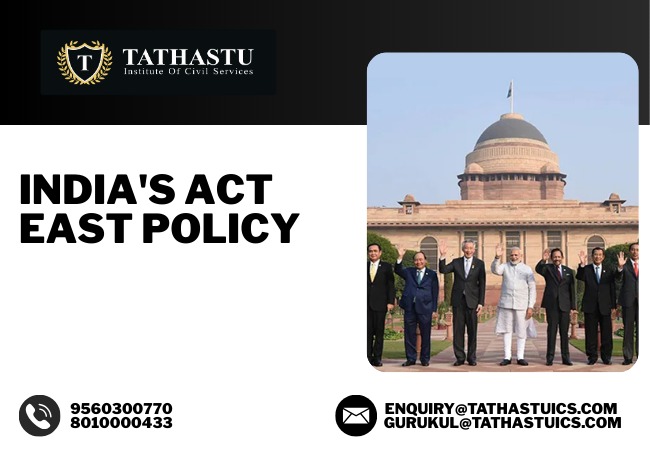The year 2024 marks the tenth anniversary of India’s Act East Policy (AEP) – a transformative diplomatic initiative aimed at deepening India’s economic, strategic, and cultural ties with countries across the Indo-Pacific region, with a special focus on the Association of Southeast Asian Nations (ASEAN).
What is Act East Policy?
- The Act East Policy, introduced by Prime Minister Narendra Modi in 2014 during the 9th East Asia Summit, signifies a transition from passive involvement to proactive engagement.
- By broadening its geographical focus to include the larger Indo-Pacific region, the policy places a greater emphasis on security, connectivity, and cultural collaboration in addition to economic integration.
Objectives of Act East Policy
The major objectives of India’s Act East Policy are as follows:
- To enhance trade, investment, and integration with global supply chains in East Asia and Southeast Asia.
- To deepen social bonds through cultural exchanges, educational partnerships, and historical ties.
- To strengthen maritime security, defence ties, and regional stability to counterbalance emerging challenges, especially from China.
Strategic Significance of Act East Policy
India’s Act East Policy aims to strengthen ties not only bilaterally but also multilaterally, through frameworks like:
- Bay of Bengal Initiative for Multi-Sectoral Technical and Economic Cooperation (BIMSTEC)
- Mekong-Ganga Cooperation (MGC)
- East Asia Summit (EAS)
- ASEAN Regional Forum (ARF)
- ASEAN Defence Ministers’ Meeting Plus (ADMM+)
Key Initiatives Under Act East Policy
Several landmark projects under India’s Act East Policy can be seen as follows:
- India-Myanmar-Thailand Trilateral Highway: This project is linking India’s Northeast with Southeast Asia, facilitating trade and travel.
- Kaladan Multi-Modal Transit Transport Project: This project connects India’s landlocked Northeast with Myanmar’s Sittwe Port for efficient cargo movement.
- Agartala-Akhaura Rail Link: This link boosts cross-border rail connectivity with Bangladesh.
- Digital Public Infrastructure (DPI): This project promotes digital collaboration between India and ASEAN.
- Mekong-India Economic Corridor: This corridor connects India’s eastern coast with Southeast Asia through infrastructure development.
- Quick Impact Projects (QIPs): Grassroots-level development projects in Cambodia, Laos, Myanmar, and Vietnam.
Challenges faced by India’s Act East Policy
India faces challenges in fully realising the potential of its Act East Policy:
- China’s Dominance: China’s massive economic influence in ASEAN and the Indo-Pacific complicates India’s efforts to expand its footprint. China-ASEAN trade, for instance, reached $ 911.7 billion in 2023, overshadowing India’s presence.
- Infrastructure Delays: Projects like the Kaladan Multi-modal Transit Project have experienced delays and cost overruns.
- Security Concerns: Political instability in neighboring countries and the influx of refugees pose risks to border security, particularly in Northeast India.
- Trade Deficit: India’s widening trade deficit with ASEAN, reaching approximately $ 44 billion in 2023, underscores the need for renegotiating trade agreements and boosting exports.
Way Forward
India needs:
- To expedite infrastructure projects and enhance regional connectivity.
- To strengthen security cooperation, especially maritime security in the Indian Ocean and South China Sea.
- To address the trade imbalance through renegotiation of trade pacts like the ASEAN Trade in Goods Agreement (ATIGA).
- To deepen cultural diplomacy by leveraging shared heritage and people-to-people ties.
- To foster multilateral cooperation with regional partners such as Japan, Australia, and Taiwan to collectively address challenges like climate change and digital economy transformation.
India’s Act East Policy is pivotal to its vision of a prosperous, secure, and integrated Indo-Pacific region.

